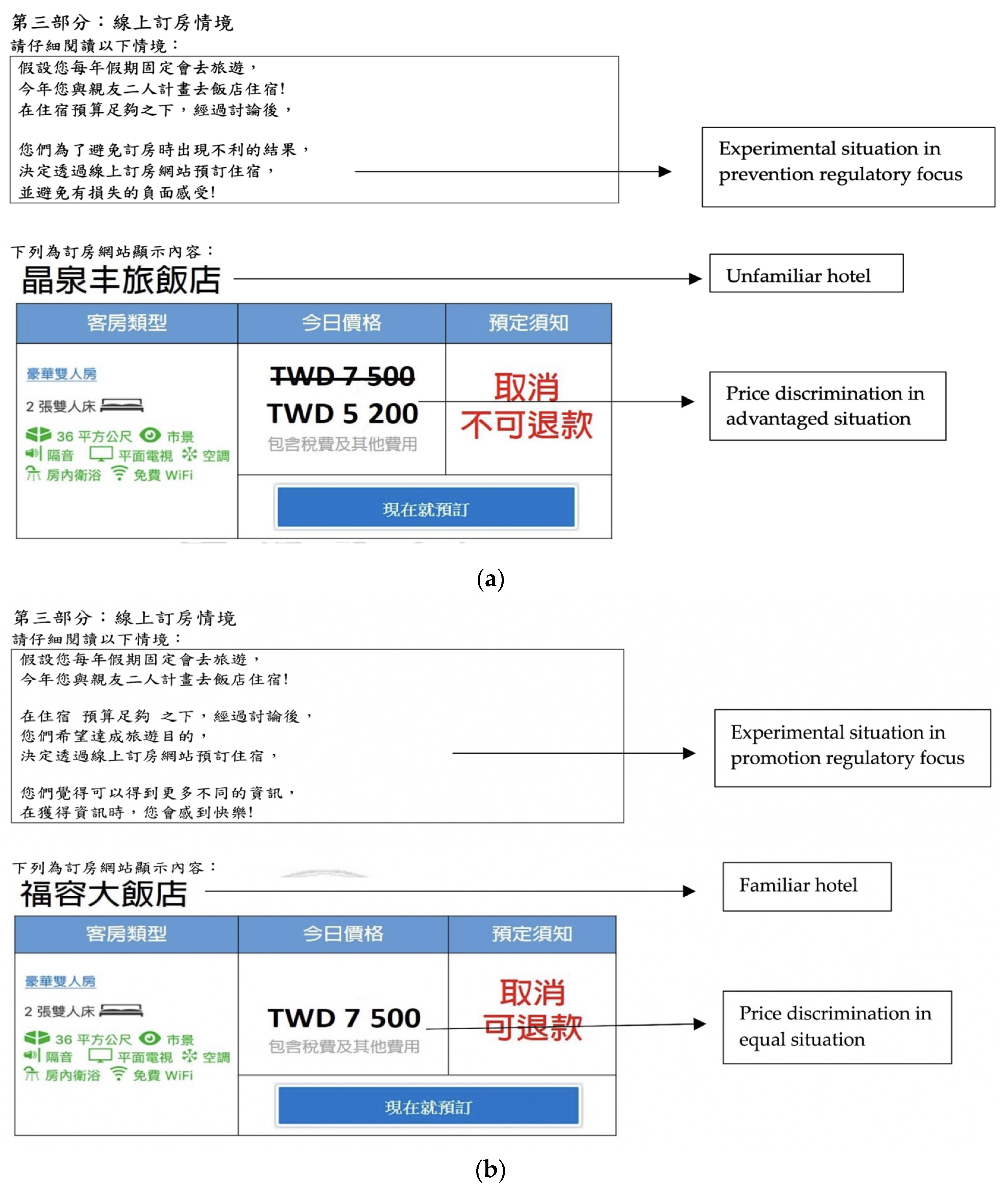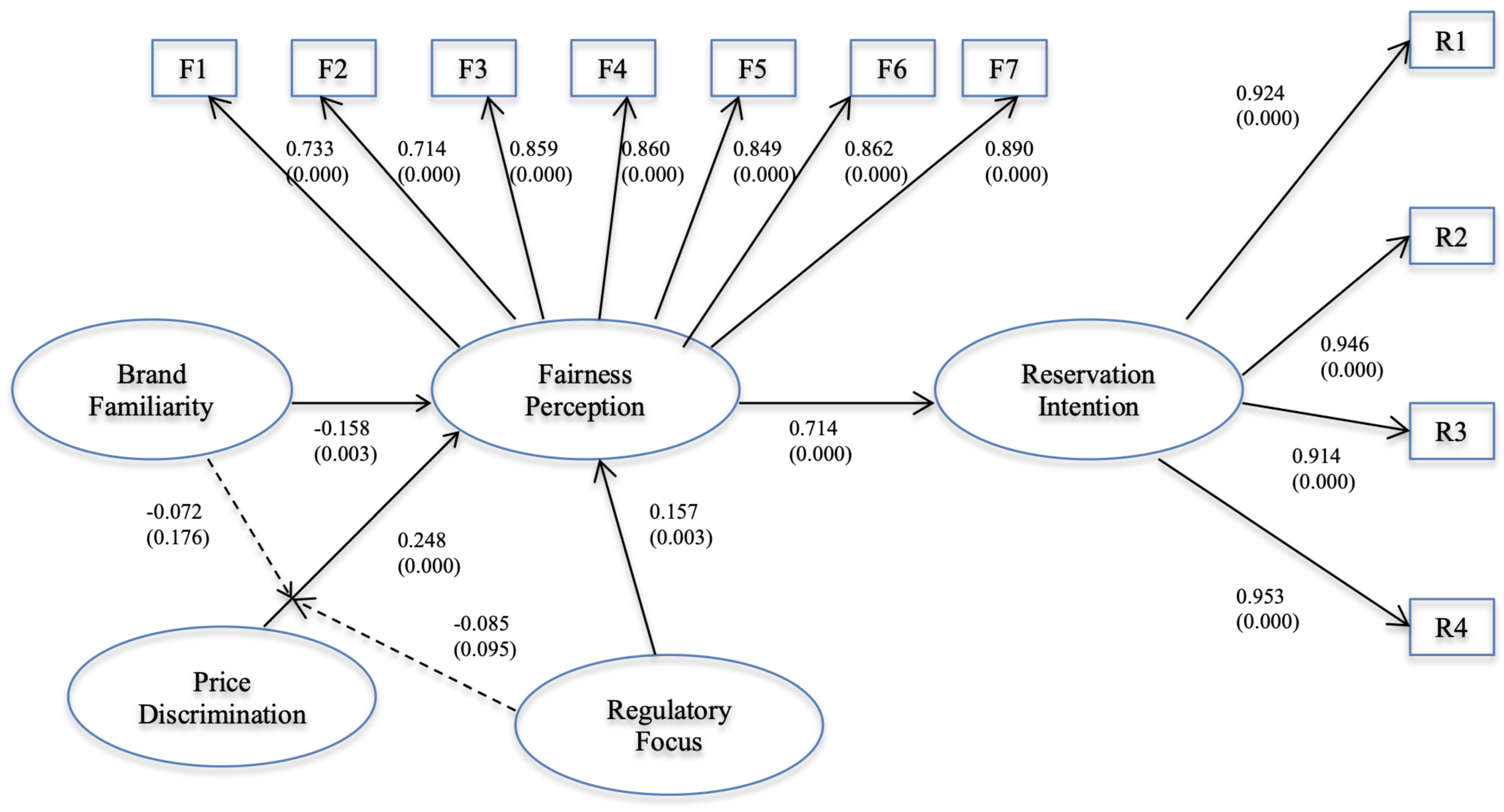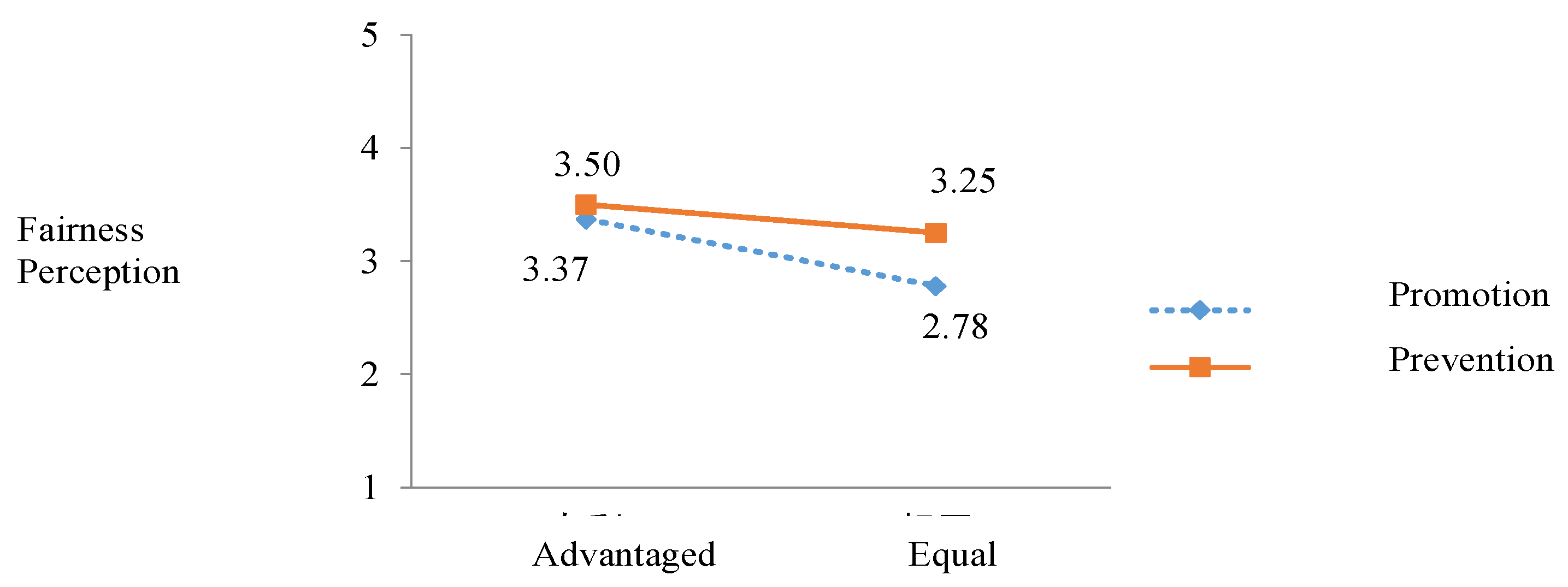The Effect of Price Discrimination on Fairness Perception and Online Hotel Reservation Intention
Abstract
1. Introduction
2. Literature Review
2.1. Fairness Perception
2.2. Price Discrimination and Fairness Perception
2.3. Brand Familiarity and Fairness Perception
2.4. Regulatory Focus and Fairness Perception
2.5. Reservation Intention and Fairness Perception
3. Materials and Methods
3.1. Research Framework
3.2. Experimental Design and Procedure
3.3. Sample
3.4. Measurement
4. Results
4.1. Manipulation Checks and Reliability and Validity
4.2. Hypothesis Testing
5. Discussion and Implications
5.1. Theoretical Implications
5.2. Managerial Implications
6. Conclusions
Author Contributions
Funding
Institutional Review Board Statement
Informed Consent Statement
Data Availability Statement
Conflicts of Interest
References
- How to Win the Hearts and Trust of Taiwanese Consumers. Available online: https://www.infocubic.co.jp/en/blog/taiwan/how-to-win-the-hearts-and-trust-of-taiwanese-consumers (accessed on 18 June 2023).
- Tourism Bureau. 2021 Survey of Travel by R.O.C. Citizens; Tourism Bureau: Taipei, Taiwan, 2021. [Google Scholar]
- Liao, K.P.; Wang, K.C.; Kung, S.C.; Gao, Y.G.; Yu, C.M. Strive for the best? Exploring the establishment of hotels’ business ecosystem through coopetition with online booking platform. J. Tour. Leis. 2021, 27, 195–244. [Google Scholar] [CrossRef]
- Ni, J.J.; Wang, L.Y.; Lin, T.M.Y. A comparative analysis of the online reviews from online booking platforms in hospitality industry—Evidence of Agoda and Airbnb. J. Tour. Leis. 2020, 26, 259–282. [Google Scholar] [CrossRef]
- Lee, C.M.; Xuan, Y.; Wan, W.L. The study of key factors affecting cross-strait consumers’ selection of online travel agent. Soochow J. Econ. Bus. 2018, 97, 63–102. [Google Scholar]
- Lien, C.H.; Wen, M.J.; Huang, L.C.; Wu, K.L. Online hotel booking: The effects of brand image, price, trust and value on purchase intentions. Asia Pacific Manag. Rev. 2015, 20, 210–218. [Google Scholar] [CrossRef]
- Teng, Y.M.; Wu, K.S.; Chou, C.Y. Price or convenience: What is more important for online and offline bookings? A study of a five-star resort hotel in Taiwan. Sustainability 2020, 12, 3972. [Google Scholar] [CrossRef]
- Biswas, A. The moderating role of brand familiarity in reference price perceptions. J. Bus. Res. 1992, 25, 251–262. [Google Scholar] [CrossRef]
- Völckner, F.; Hofmann, J. The price-perceived quality relationship: A meta-analytic review and assessment of its determinants. Mark. Lett. 2007, 18, 181–196. [Google Scholar] [CrossRef]
- Adams, J.S. Inequity in social exchange. J. Exp. Soc. Psychol. 1965, 2, 267–299. [Google Scholar] [CrossRef]
- Huppertz, W.J.; Arenson, J.S.; Evans, H.R. An application of equity theory to buyer-seller exchange situations. J. Mark. Res. 1978, 15, 250–260. [Google Scholar] [CrossRef]
- Kahneman, D.; Knetsch, J.L.; Thaler, R.H. Fairness and the assumptions of economics. J. Bus. 1986, 59, S285–S300. [Google Scholar] [CrossRef]
- Priester, A.; Robert, T.; Roth, S. A special price just for you: Effects of personalized dynamic pricing on consumer fairness perceptions. J. Revenue Pricing Manag. 2020, 19, 99–112. [Google Scholar] [CrossRef]
- Campbell, M.C. Perceptions of price unfairness: Antecedents and consequences. J. Mark. Res. 1999, 36, 187–199. [Google Scholar] [CrossRef]
- Huang, J.H.; Chang, C.T.; Chen, C.Y.H. Perceived Fairness of Pricing on the Internet. J. Econ. Psychol. 2005, 26, 343–361. [Google Scholar] [CrossRef]
- Lii, Y.-S.; Sy, E. Internet Differential Pricing: Effects on Consumer Price Perception, Emotions, and Behavioral Responses. Comput. Hum. Behav. 2009, 25, 770–777. [Google Scholar] [CrossRef]
- Alba, J.W.; Hutchinson, J.W. Dimensions of consumer expertise. J. Consum. Res. 1987, 13, 411–454. [Google Scholar] [CrossRef]
- Sundaram, D.S.; Webster, C. The role of brand familiarity on the impact of word-of-mouth communication on brand evaluations. In Advances in Consumer Research, 26th ed.; Arnould, E.J., Scott, L.M., Eds.; Association for Consumer Research: Provo, UT, USA, 1999; pp. 664–670. [Google Scholar]
- Xia, L.; Monroe, K.B.; Cox, J.L. The price is unfair! A conceptual framework of price fairness perceptions. J. Mark. 2004, 68, 1–15. [Google Scholar] [CrossRef]
- Shehryar, O.; Hunt, D.M. Buyer behavior and procedural fairness in pricing: Exploring the moderating role of product familiarity. J. Prod. Brand. 2005, 14, 271–276. [Google Scholar] [CrossRef]
- Son, J.; Jin, B.E. When do high prices lead purchase intention? Testing two layers of moderation effects. Asia Pac. J. Mark. Logist. 2019, 11, 1516–1531. [Google Scholar] [CrossRef]
- Grewal, D.; Hardesty, D.M.; Iyer, G.R. The effects of buyer identification and purchase timing on consumers’ perceptions of trust, price fairness, and repurchase intentions. J. Interact. Mark. 2004, 18, 87–100. [Google Scholar] [CrossRef]
- Haws, K.L.; Dholakia, U.M.; Bearden, W.O. An assessment of chronic regulatory focus measures. J. Mark. Res. 2010, 47, 967–982. [Google Scholar] [CrossRef]
- Higgins, E.T. Promotion and prevention: Regulatory focus as a motivational principle. Adv. Exp. Soc. Psychol. 1998, 30, 1–46. [Google Scholar] [CrossRef]
- Das, G. Retail shopping behaviour: Understanding the role of regulatory focus theory. Int. Rev. Retail Distrib. Consum. Res. 2015, 25, 431–445. [Google Scholar] [CrossRef]
- Krishna, A.; Ried, S.; Meixner, M. State-trait interactions in regulatory focus determine impulse buying behavior. PLoS ONE 2021, 16, e0253634. [Google Scholar] [CrossRef] [PubMed]
- Lin, C.T.; Chen, C.W.; Wang, S.J.; Lin, C.C. The influence of impulse buying toward consumer loyalty in online shopping: A regulatory focus theory perspective. J. Ambient. Intell. Humaniz. Comput. 2018, 1–11. [Google Scholar] [CrossRef]
- Pham, M.T.; Chang, H.H. Regulatory focus, regulatory fit, and the search and consideration of choice alternatives. J. Consum. Res. 2010, 37, 626–640. [Google Scholar] [CrossRef]
- Boesen-Mariani, S.; Gomez, P.; Gavard-Perret, M.L. L’orientation régulatrice: Un concept prometteur en marketing. Rech. Appl. Mark. 2010, 25, 87–106. [Google Scholar] [CrossRef]
- Abrate, G.; Nicolau, J.L.; Viglia, G. The impact of dynamic price variability on revenue maximization. Tour. Manag. 2019, 74, 224–233. [Google Scholar] [CrossRef]
- Bigne, E.; Nicolau, J.L.; William, E. Advance booking across channels: The effects on dynamic pricing. Tour. Manag. 2021, 86, 104341. [Google Scholar] [CrossRef]
- Jiang, L.; Erdem, M. Effects of Revenue Management Pricing Strategies on Perceived Fairness. J. Hosp. Mark. Manag. 2018, 27, 424–442. [Google Scholar] [CrossRef]
- Riquelme, I.P.; Roman, S.; Cuestas, P.J. Does it matter who gets a better price? Antecedents and consequences of online price unfairness for advantaged and disadvantaged consumers. Tour. Manag. Perspect. 2021, 40, 100902. [Google Scholar] [CrossRef]
- Da Costa, M.F.; de Angelo, C.F.; de Farias, S.A. Up, up and away! The metaphor of verticality and the moderating role of regulatory focus in price assessments. Rev. Gest. 2023, 30, 18–31. [Google Scholar] [CrossRef]
- Lee, C.H.; Su, J.L.; Chen, E.Y.I. The relationship between perceived fairness, recovery satisfaction, and behavior intention: The moderating role of service failure severity. Chung Yuan Manag. Rev. 2014, 12, 1–25. [Google Scholar]
- Clemmer, E.C.; Schneider, B. Fair service. In Advances in Service Marketing and Management: Research and Practice; Swartz, T.A., Bowen, D.E., Brown, S.W., Eds.; JAI: Geenwich, CT, USA, 1996; pp. 109–126. [Google Scholar]
- Oliver, R.L.; Swan, J.E. Consumer perceptions of interpersonal equity and satisfaction in transactions: A field survey approach. J. Mark. 1980, 53, 21–35. [Google Scholar] [CrossRef]
- Homburg, C. Customers’ reactions to price increases: Do customer satisfaction and perceived motive fairness matter? J. Acad. Mark. Sci. 2005, 33, 36–49. [Google Scholar] [CrossRef]
- Lastner, M.M.; Fennell, P.; Folse, J.A.G.; Rice, D.H.; Porter, M. I guess that is fair: How the efforts of other customers influence buyer price fairness perceptions. Psychol. Mark. 2019, 36, 700–715. [Google Scholar] [CrossRef]
- Yang, M.X. ; Individual Economy 101; Tsang Hai Publishing: Taichung, Taiwan, 2009. [Google Scholar]
- Gilliland, S.W. The perceived fairness of selection systems: An organizational justice perspective. Acad. Manag. Rev. 1993, 18, 694–734. [Google Scholar] [CrossRef]
- Ramaswami, S.N.; Singh, J. Antecedents and consequences of merit pay fairness for industrial salespeople. J. Mark. 2003, 67, 46–66. [Google Scholar] [CrossRef]
- Dickson, P.R.; Kalapurakal, R. The use and perceived fairness of price-setting rules in the bulk electricity market. J. Econ. Psychol. 1994, 15, 427–448. [Google Scholar] [CrossRef]
- Campbell, M.C. “Says who?!” How the source of price information and affect influence perceived price (Un)fairness. J. Mark. Res. 2007, 44, 261–271. [Google Scholar] [CrossRef]
- Prideaux, G.D.; Baker, W.J. Strategies and Structures: The Processing of Relative Clauses; John Benjamins: Philadelphia, PA, USA, 1987. [Google Scholar]
- Campbell, M.C.; Keller, K.L. Brand familiarity and advertising repetition effects. J. Consum. Res. 2003, 30, 292–304. [Google Scholar] [CrossRef]
- Cowley, E.; Mitchell, A.A. The moderating effect of product knowledge on the learning and organization of product information. J. Consum. Res. 2003, 30, 443–454. [Google Scholar] [CrossRef]
- Han, C.M. Country image: Halo or summary construct? J. Mark. Res. 1989, 26, 222–229. [Google Scholar] [CrossRef]
- Kamins, M.A.; Marks, L.J. The perception of kosher as a third party certification claim in advertising for familiar and unfamiliar brands. J. Acad. Mark. Sci. 1991, 19, 177–185. [Google Scholar] [CrossRef]
- Krishnan, J.; Krishnan, J. The role of economic trade-offs in the audit opinion decision: An empirical analysis. J. Account. Audit. Financ. 1996, 11, 565–586. [Google Scholar] [CrossRef]
- Higgins, E.T. Beyond pleasure and pain. Am. Psychol. 1997, 52, 1280–1300. [Google Scholar] [CrossRef] [PubMed]
- Förster, J.; Grant, H.; Idson, L.C.; Higgins, E.T. Success/failure feedback, expectancies, and approach/avoidance motivation: How regulatory focus moderates classic relations. J. Exp. Soc. Psychol. 2001, 37, 253–260. [Google Scholar] [CrossRef]
- Ghiassaleh, A.; Kocher, B.; Czellar, S. Best seller!? Unintended negative consequences of popularity signs on consumer choice behavior. Int. J. Res. Mark. 2020, 37, 805–820. [Google Scholar] [CrossRef]
- Lee, A.Y.; Aaker, J.L. Bringing the Frame into Focus: The Influence of Regulatory Fit on Processing Fluency and Persuasion. J. Pers. Soc. Psychol. 2004, 86, 205–218. [Google Scholar] [CrossRef]
- Cropanzano, R.; Paddock, L.; Rupp, D.E.; Bagger, J.; Baldwin, A. How regulatory focus impacts the process-by-outcome interaction for perceived fairness and emotions. Organ. Behav. Hum. Decis. Process. 2008, 105, 36–51. [Google Scholar] [CrossRef]
- Lee, K.; Choi, J.; Li, Y.J. Regulatory focus as a predictor of attitudes toward partitioned and combined pricing. J. Consum. Psychol. 2014, 24, 355–362. [Google Scholar] [CrossRef]
- Li, Y.S.; Yang, J.Y.; Teng, T.W. The impact of price discrimination on price fairness, emotions and behavioral responses. In Proceeding of 2006 The 10th Conference on Interdisciplinary and Multifunctional Business Management, New Taipei, Taiwan, 27 May 2006. [Google Scholar]
- Dodds, W.B.; Monroe, K.B.; Grewal, D. Effects of price, brand and store information on buyers’ product evaluations. J. Mark. Res. 1991, 28, 307–319. [Google Scholar] [CrossRef]
- Schiffman, L.G.; Kanuk, L.L. Consumer Behavior, 7th ed.; Prentice Hall: New York, NY, USA, 2000; pp. 15–36. [Google Scholar]
- Dholakia, R.R.; Zhao, M. Effects of online store attributes on customer satisfaction and repurchase intentions. Int. J. Retail. Distrib. Manag. 2010, 38, 482–496. [Google Scholar] [CrossRef]
- Suter, T.A.; Hardesty, D.M. Maximizing earnings and price fairness perceptions in online consumer-to-consumer auctions. J. Retail. 2005, 81, 307–317. [Google Scholar] [CrossRef]
- Martins, M.; Monroe, K.B. Perceived price fairness: A new look at an old construct. Adv. Consum. Res. 1994, 21, 75–78. [Google Scholar]
- Schmidt, L.; Bornschein, R.; Maier, E. The effect of privacy choice in cookie notices on consumers’ perceived fairness of frequent price changes. Psychol. Mark. 2020, 37, 1263–1276. [Google Scholar] [CrossRef]
- Bolton, L.E.; Warlop, L.; Alba, J.W. Consumer perceptions of price unfairness. J. Consum. Res. 2003, 29, 474–491. [Google Scholar] [CrossRef]
- Cronin, J.J., Jr.; Brady, M.K.; Hult, G.T.M. Assessing the effects of quality, value, and customer satisfaction on consumer behavioral intentions in service environments. J. Retail. 2000, 76, 193–218. [Google Scholar] [CrossRef]
- Tourism Bureau. 2018 Survey of Travel by R.O.C. Citizens; Tourism Bureau: Taipei, Taiwan, 2019. [Google Scholar]
- Kent, R.J.; Allen, C.T. Competitive interference effects on consumer memory for advertising: The role of brand familiarity. J. Mark. 1994, 58, 94–107. [Google Scholar] [CrossRef]
- Lin, L.Y.; Cheng, P.S. The effects of price promotion, brand familiarity, and consumers’ perceived benefits of sale promotion on brand evaluation—A case of convenience chain store in Taipei City. Mark. Rev. 2005, 2, 523–554. [Google Scholar]
- Adams, J.S. Towards an understanding of inequity. J. Abnorm. Soc. Psychol. 1963, 67, 422–436. [Google Scholar] [CrossRef]
- Hauser, D.J.; Ellsworth, P.C.; Gonzalez, R. Are manipulation checks necessary? Front. Psychol. 2018, 9, 998. [Google Scholar] [CrossRef] [PubMed]
- Hair, J.F., Jr.; Hult, G.T.M.; Ringle, C.; Sarstedt, M. A Primer on Partial Least Squares Structural Equation Modeling (PLS-SEM); Sage Publications Inc.: Thousand Oaks, CA, USA, 2016. [Google Scholar]
- Fornell, C.; Larcker, D.F. Evaluating structural equation models with unobservable variables and measurement error. J. Mark. Res. 1981, 18, 39–50. [Google Scholar] [CrossRef]
- Middleton, V.T.; Fyall, A.; Morgan, M.; Ranchod, A. Marketing in Travel and Tourism; Butterworth-Heinemann: Oxford, UK, 2009. [Google Scholar]





| Experimental Groups | Price Discrimination | Brand Familiarity | Regulatory Focus |
|---|---|---|---|
| Group 1 | equal price (refundable) | familiar | promotion |
| Group 2 | prevention | ||
| Group 3 | unfamiliar | promotion | |
| Group 4 | prevention | ||
| Group 5 | advantaged price (non-refundable) | familiar unfamiliar | promotion |
| Group 6 | prevention | ||
| Group 7 | promotion | ||
| Group 8 | prevention |
| Research Variables | Operationalized Items | Sources |
|---|---|---|
| Price Discrimination |
| |
| Brand Familiarity |
| [67,68] |
| Regulatory Focus |
| |
| Fairness Perception |
| [12,22,69] |
| Reservation Intention |
| [60] |
| Structure | Fairness Perception | Reservation Intention |
|---|---|---|
| Fairness perception | 0.802 * | |
| Reservation intention | 0.795 | 0.932 * |
| Path | Path Coefficient | t-Value | p-Value |
|---|---|---|---|
| Price discrimination → fairness perception | 0.248 *** | 4.707 | 0.000 |
| Brand familiarity → fairness perception | −0.158 *** | 3.007 | 0.003 |
| Regulatory focus → fairness perception | 0.157 *** | 3.003 | 0.003 |
| Price discrimination × brand familiarity → fairness perception | −0.072 | 1.362 | 0.176 |
| Price discrimination × regulatory focus → fairness perception | −0.085 * | 1.660 | 0.095 |
| Fairness perception → reservation intention | 0.714 *** | 35.087 | 0.000 |
Disclaimer/Publisher’s Note: The statements, opinions and data contained in all publications are solely those of the individual author(s) and contributor(s) and not of MDPI and/or the editor(s). MDPI and/or the editor(s) disclaim responsibility for any injury to people or property resulting from any ideas, methods, instructions or products referred to in the content. |
© 2023 by the authors. Licensee MDPI, Basel, Switzerland. This article is an open access article distributed under the terms and conditions of the Creative Commons Attribution (CC BY) license (https://creativecommons.org/licenses/by/4.0/).
Share and Cite
Chen, Y.-F.; Pang, T.-T.; Kuslina, B.H. The Effect of Price Discrimination on Fairness Perception and Online Hotel Reservation Intention. J. Theor. Appl. Electron. Commer. Res. 2023, 18, 1320-1337. https://doi.org/10.3390/jtaer18030067
Chen Y-F, Pang T-T, Kuslina BH. The Effect of Price Discrimination on Fairness Perception and Online Hotel Reservation Intention. Journal of Theoretical and Applied Electronic Commerce Research. 2023; 18(3):1320-1337. https://doi.org/10.3390/jtaer18030067
Chicago/Turabian StyleChen, Yi-Fen, Tzu-Ting Pang, and Boedi Hartadi Kuslina. 2023. "The Effect of Price Discrimination on Fairness Perception and Online Hotel Reservation Intention" Journal of Theoretical and Applied Electronic Commerce Research 18, no. 3: 1320-1337. https://doi.org/10.3390/jtaer18030067
APA StyleChen, Y.-F., Pang, T.-T., & Kuslina, B. H. (2023). The Effect of Price Discrimination on Fairness Perception and Online Hotel Reservation Intention. Journal of Theoretical and Applied Electronic Commerce Research, 18(3), 1320-1337. https://doi.org/10.3390/jtaer18030067






